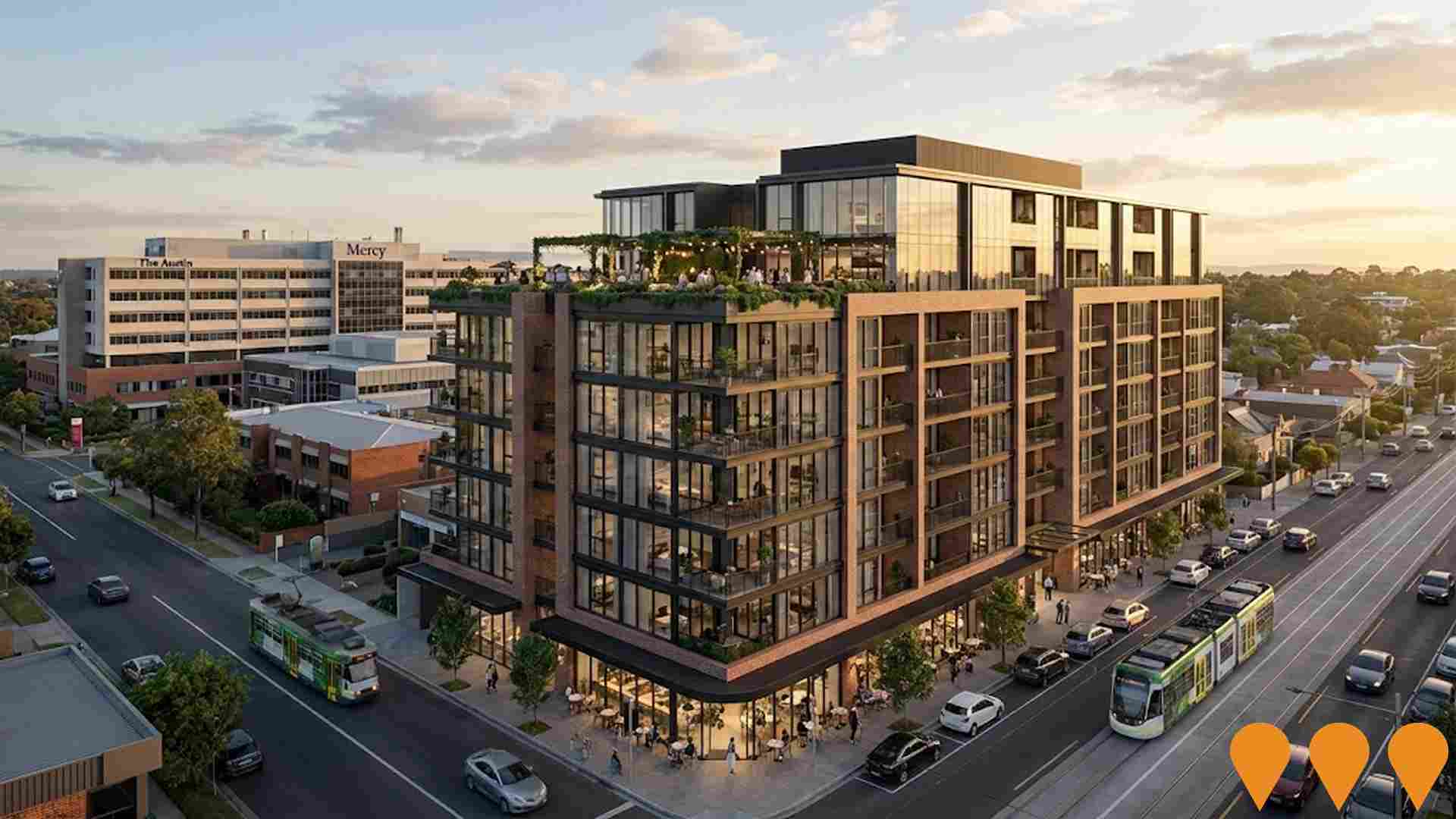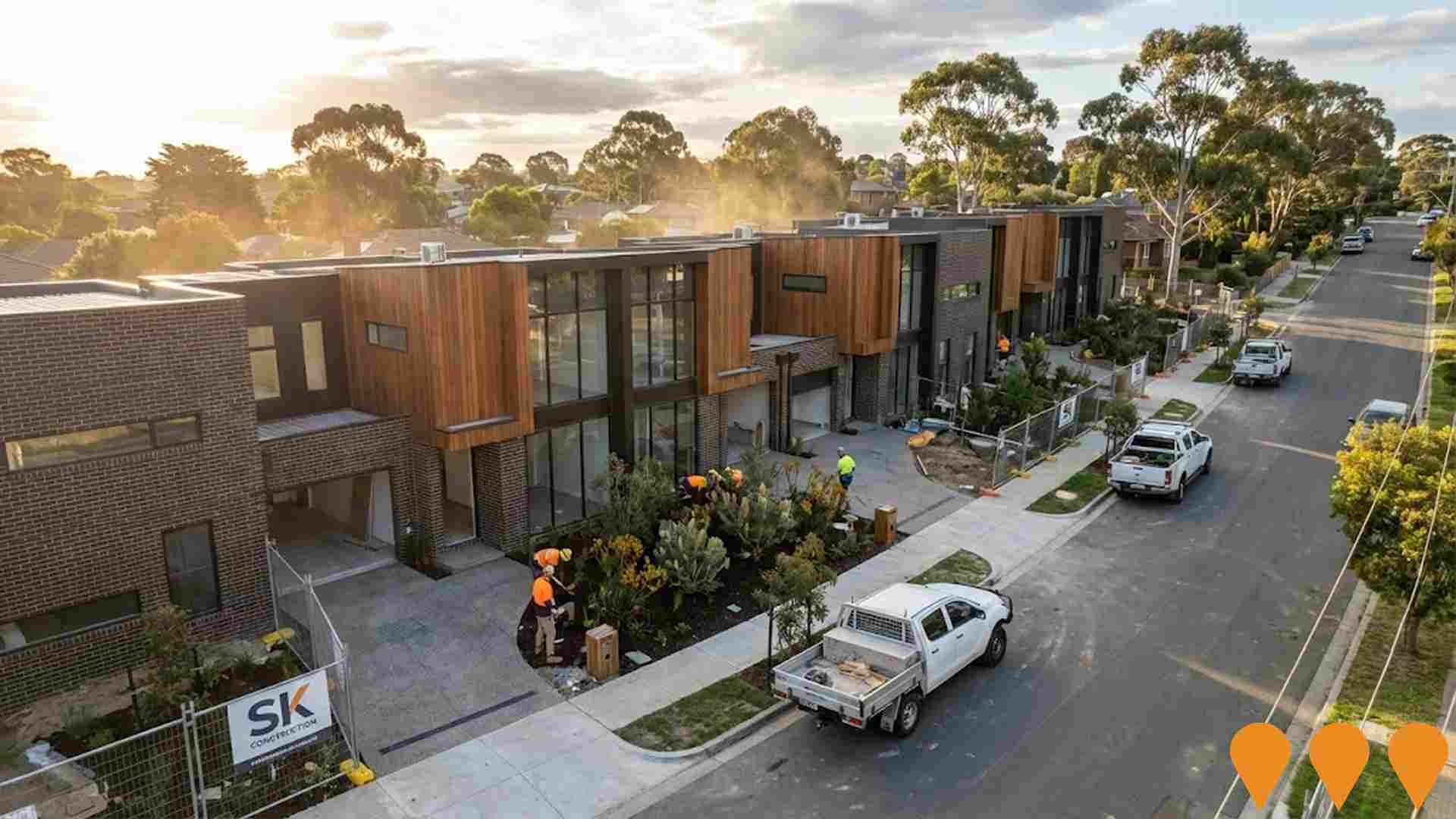Chart Color Schemes
est. as @ -- *
ABS ERP | -- people | --
2021 Census | -- people
Sales Activity
Curious about local property values? Filter the chart to assess the volume and appreciation (including resales) trends and regional comparisons, or scroll to the map below view this information at an individual property level.
Find a Recent Sale
Sales Detail
Population
Population growth drivers in Heidelberg West are strong compared to national averages based on AreaSearch's ranking of recent, and medium to long-term trends
Heidelberg West's population was around 16,994 as of August 2025. This figure reflected an increase of 2,142 people from the 2021 Census, which reported a population of 14,852. The change was inferred from the estimated resident population of 16,834 in June 2024 and an additional 928 validated new addresses since the Census date. This resulted in a density ratio of 2,540 persons per square kilometer, placing Heidelberg West in the upper quartile nationally according to AreaSearch's assessment. The area's growth rate of 14.4% since the 2021 census exceeded both the SA3 area (5.0%) and the national average, indicating its status as a growth leader in the region. Overseas migration contributed approximately 67.3% of overall population gains during recent periods, although all drivers including natural growth and interstate migration were positive factors.
AreaSearch adopted ABS/Geoscience Australia projections for each SA2 area released in 2024 with a base year of 2022. For areas not covered by this data, AreaSearch utilized the VIC State Government's Regional/LGA projections released in 2023 with adjustments made employing a method of weighted aggregation of population growth from LGA to SA2 levels. Growth rates by age group were applied across all areas for years 2032 to 2041. Future population dynamics predict exceptional growth, placing Heidelberg West in the top 10 percent of statistical areas analysed by AreaSearch. The area is expected to expand by 9,963 persons by 2041 based on the latest population numbers, recording a gain of 56.9% over the 17-year period.
Frequently Asked Questions - Population
Development
AreaSearch assessment of residential development activity positions Heidelberg West among the top 25% of areas assessed nationwide
Heidelberg West granted approval for approximately 406 residential properties annually. Over the past five financial years, from FY21 to FY25, around 2,032 homes were approved, with another 363 approved in FY26 so far. The average number of people moving to the area per dwelling built over these years was 0.6.
New construction has been matching or outpacing demand, providing buyers with more options and enabling population growth. The average expected construction cost value for new properties is $401,000, which is below regional norms, offering more affordable housing options. In FY26, $71.3 million in commercial development approvals have been recorded, indicating high levels of local commercial activity. Compared to Greater Melbourne, Heidelberg West has 292.0% more construction activity per person. Building activity has slowed in recent years but remains significantly above the national average, reflecting robust developer interest in the area. New development consists of 10.0% detached dwellings and 90.0% medium and high-density housing, creating more affordable entry points for downsizers, investors, and first-home buyers. This shift reflects reduced availability of development sites and addresses shifting lifestyle demands and affordability requirements.
The location has approximately 91 people per dwelling approval, indicating an expanding market. Population forecasts suggest Heidelberg West will gain 9,672 residents by 2041. Based on current development patterns, new housing supply should readily meet demand, offering good conditions for buyers and potentially facilitating population growth beyond current projections.
Frequently Asked Questions - Development
Infrastructure
Heidelberg West has strong levels of nearby infrastructure activity, ranking in the top 30% nationally
Changes to local infrastructure significantly influence an area's performance. AreaSearch has identified 16 projects that may impact the area. Notable projects include Austin Health Heidelberg Repatriation Hospital Redevelopment, Austin Hospital Emergency Department Expansion, Rosanna Village Masterplan & Redevelopment, and The Austin Heidelberg. The following list details those most relevant:.
Professional plan users can use the search below to filter and access additional projects.
INFRASTRUCTURE SEARCH
 Denotes AI-based impression for illustrative purposes only, not to be taken as definitive under any circumstances. Please follow links and conduct other investigations from the project's source for actual imagery. Developers and project owners wishing us to use original imagery please Contact Us and we will do so.
Denotes AI-based impression for illustrative purposes only, not to be taken as definitive under any circumstances. Please follow links and conduct other investigations from the project's source for actual imagery. Developers and project owners wishing us to use original imagery please Contact Us and we will do so.
Frequently Asked Questions - Infrastructure
Austin Health Heidelberg Repatriation Hospital Redevelopment
Major $750m+ redevelopment of the former Repatriation Hospital site into a new integrated clinical services hub for Austin Health, including mental health, sub-acute, and veteran services.
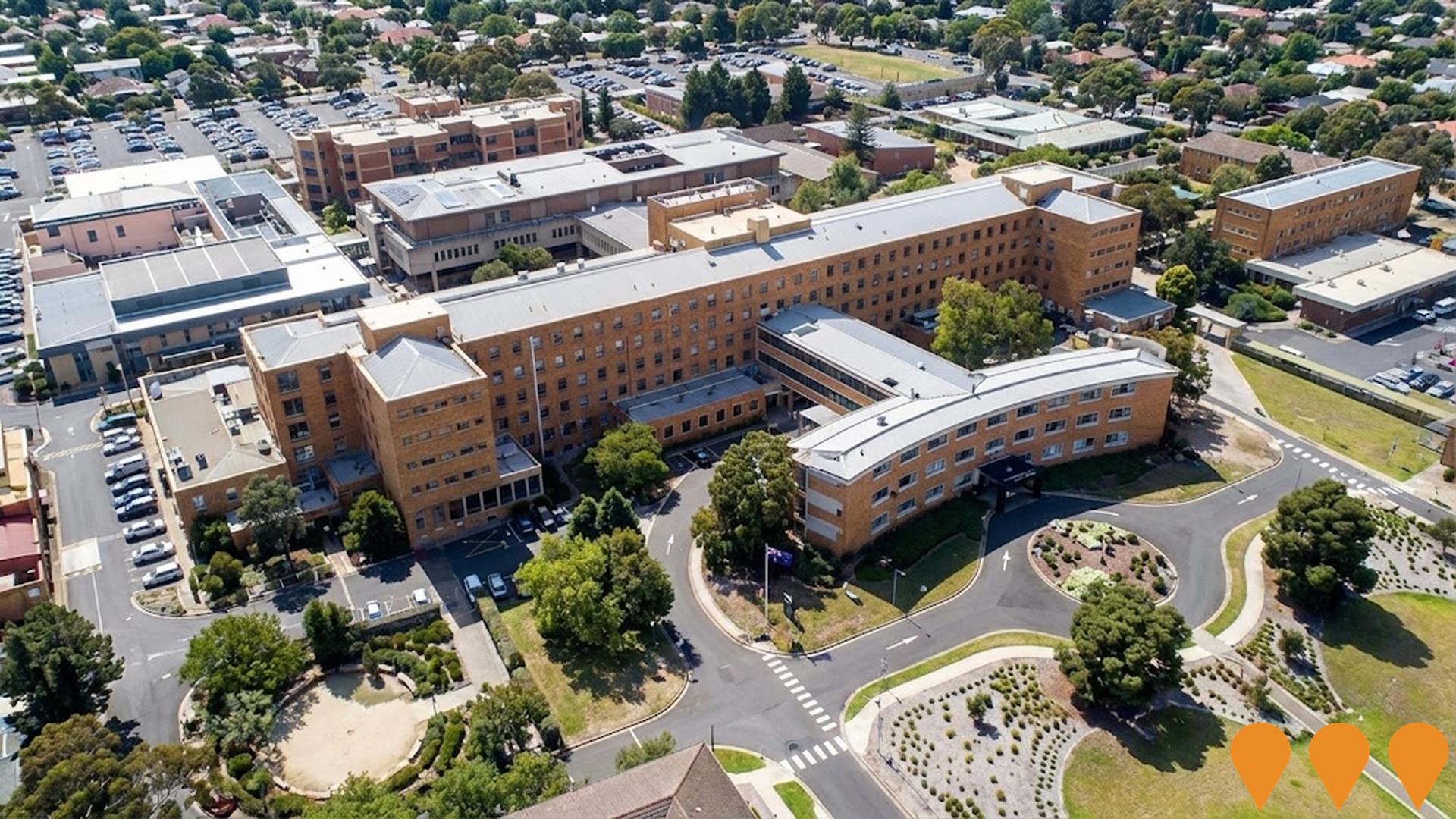
Austin Hospital Emergency Department Expansion
Victorian Government-funded $275 million expansion of the Austin Hospital Emergency Department in Heidelberg. The project will deliver 29 additional treatment spaces, a dedicated paediatric emergency area, expanded short-stay unit, new clinical administration areas, and a double-height public foyer with cafe and retail offerings. Early works commenced in 2024, main construction is underway and completion is scheduled for 2028.
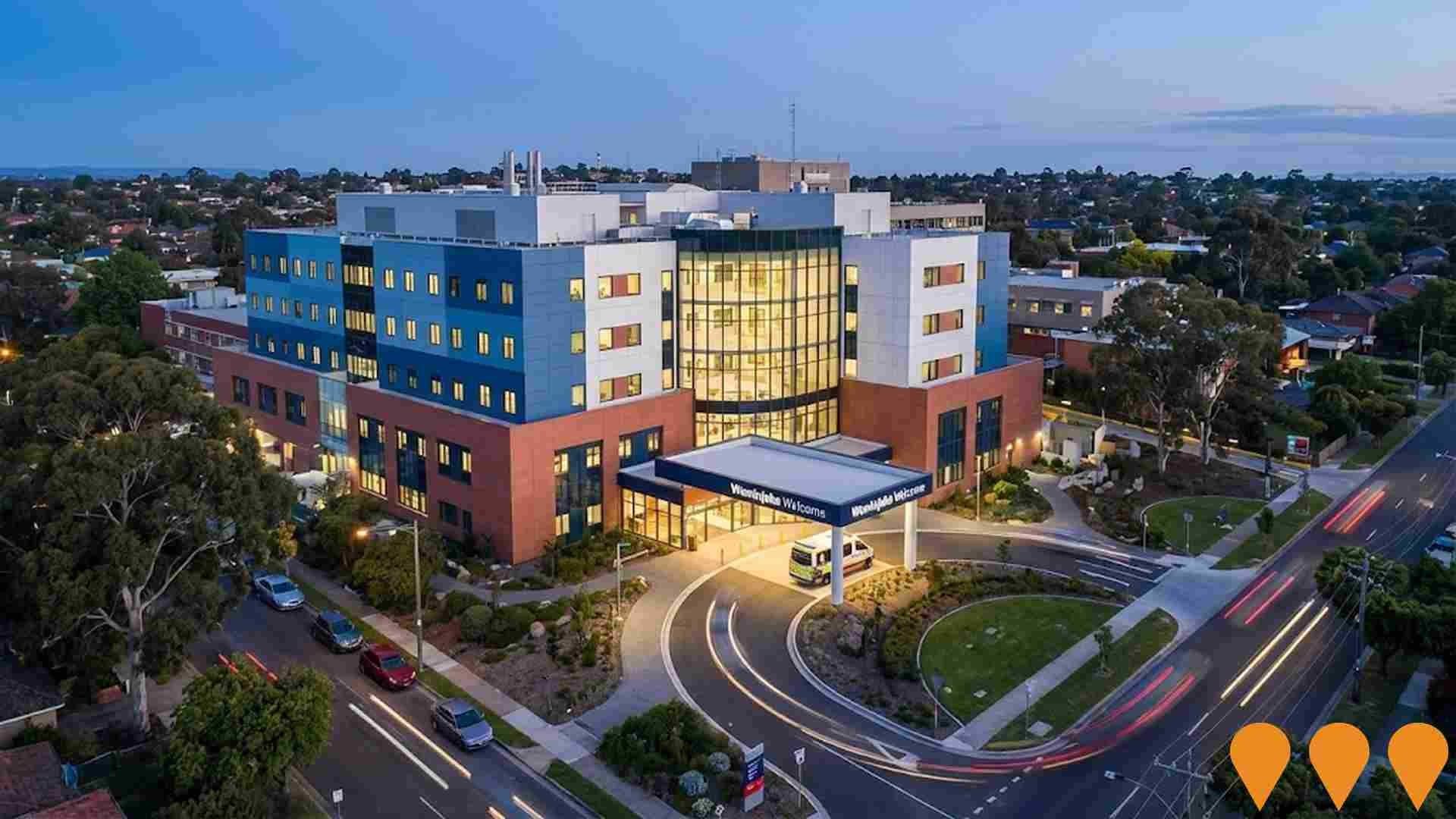
University Hill Master Planned Community
A $1 billion mixed-use master planned community by MAB Corporation spanning 104 hectares. Features residential areas home to around 3,000 residents, DFO retail outlet with 130+ national and international retailers, business parks, town centre with 40+ specialty stores, conference centre, and community facilities. The development includes 3 hectares of recreation parks, 5 hectares of wetlands, and 10 hectares of nature reserves.
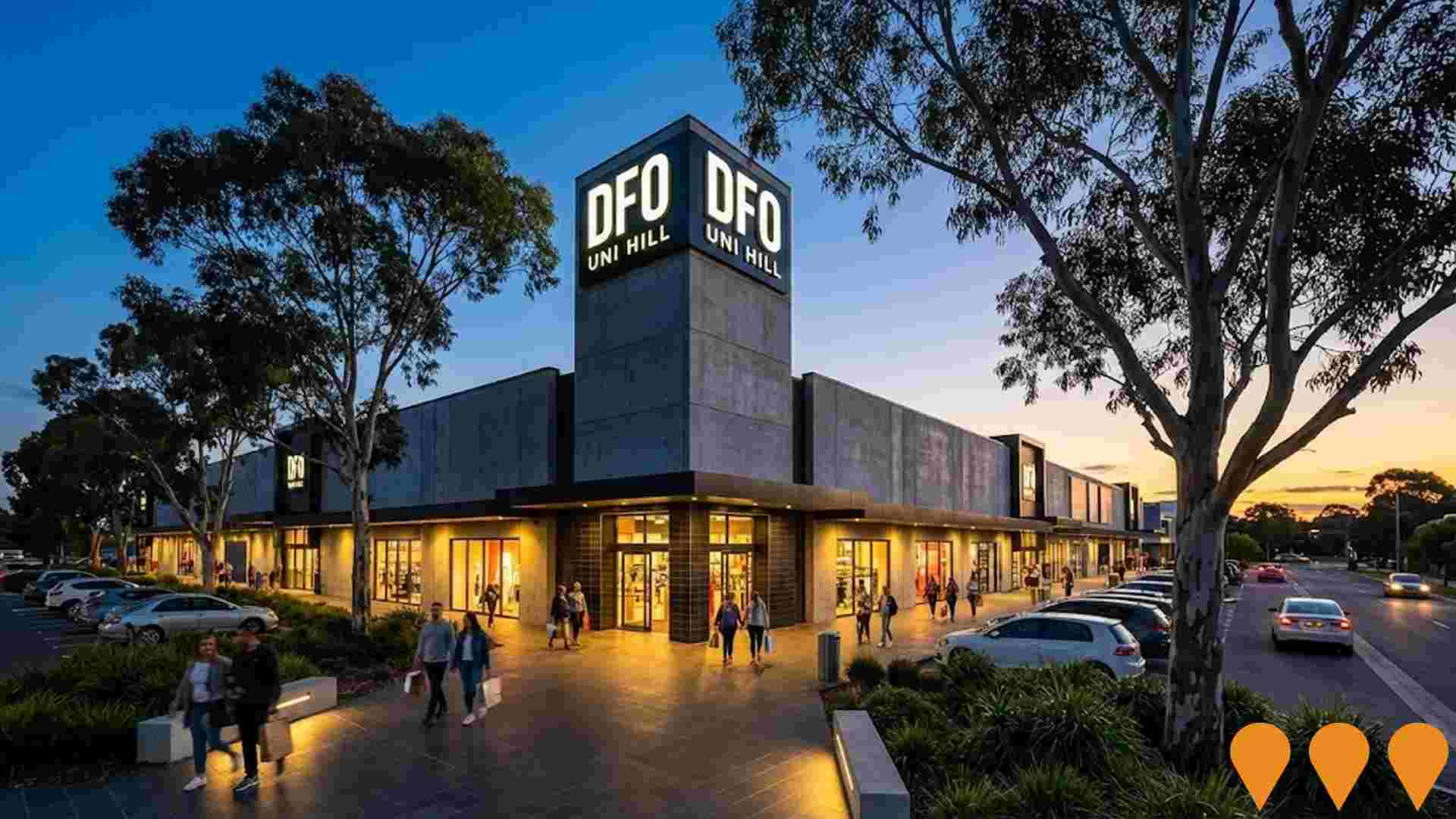
Heidelberg Structure Plan (Heidelberg Central Precinct)
A strategic place-based framework to guide the growth and evolution of the Heidelberg Major Activity Centre (MAC) over the next twenty years, recognised as a State Significant health precinct. It establishes a vision for a liveable, people-focused centre, balancing local jobs, vibrant shopping/dining, housing diversity, and high-quality design, with targeted strategies for environmentally sustainable development. The plan provides the strategic basis for changes to the Banyule Planning Scheme, including the application of a new Activity Centre Zone (ACZ) to guide development. The original project mentioned, 'Heidelberg Central,' is a key redevelopment site within the MAC.
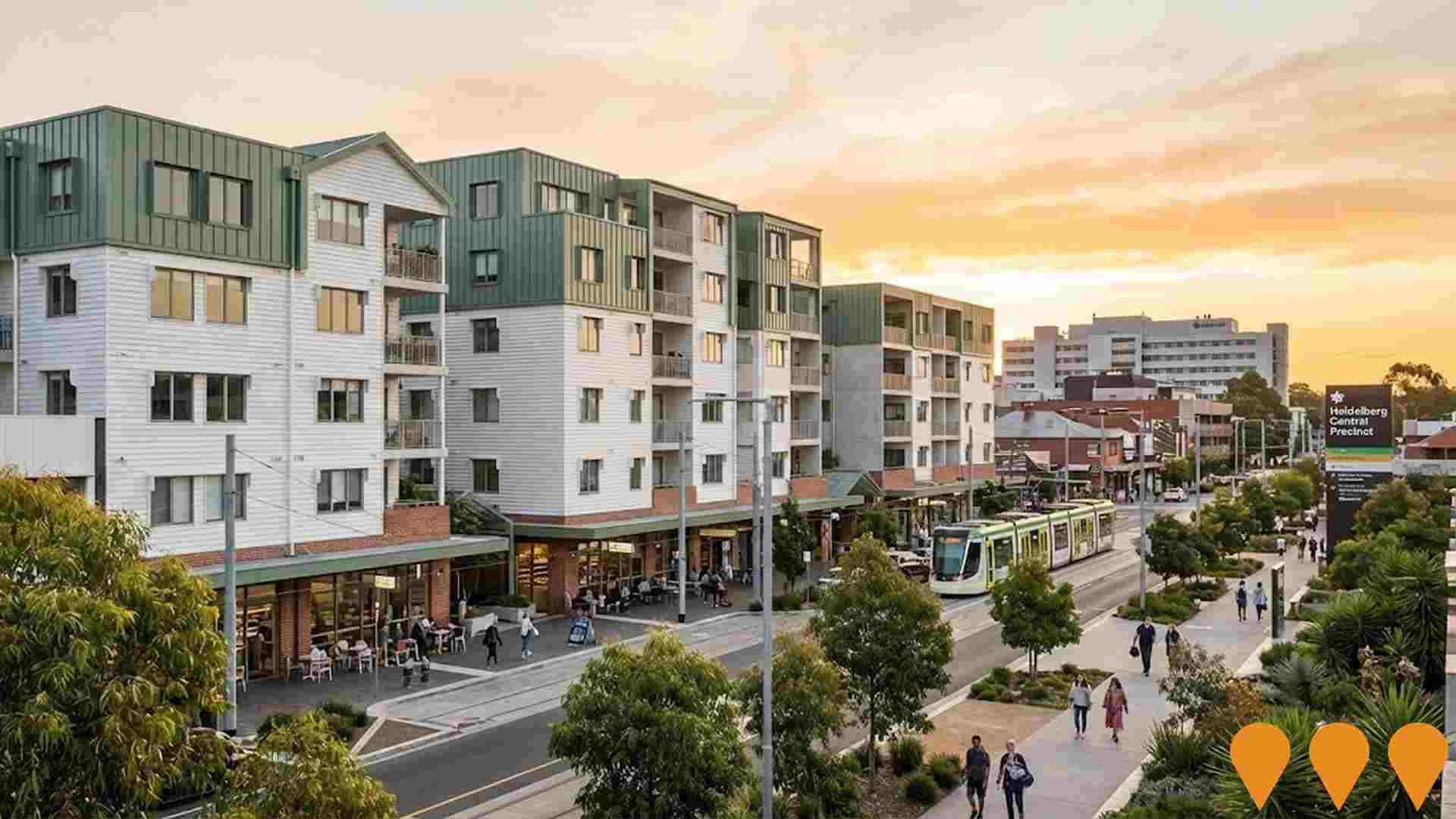
Rosanna Village Masterplan & Redevelopment
Precinct-wide renewal of Rosanna Village focused on a new three storey, 1,600 sqm Rosanna Library delivered in partnership with Woolworths, a new Woolworths supermarket, upgraded Turnham Avenue streetscapes, improved pedestrian and bus connections to Rosanna Station, a new public plaza and landscaping, and capacity for future mixed use development around the neighbourhood activity centre.

Heidelberg Structure Plan Implementation
Planning Scheme Amendment C172 implementing new height limits and urban design provisions for Heidelberg Major Activity Centre. Includes mandatory and discretionary height limits, with some areas increased by two storeys. Part of State Government's Activity Centres Program.

RMIT University Bundoora Campus Developments
Ongoing campus developments at RMIT Bundoora, featuring the recently completed Trades Innovation Centre, sustainable infrastructure upgrades through the Sustainable Urban Precincts Program, and future enhancements under the Master Plan 2045. Emphasizes engineering, science, vocational education, and student facilities for northern Melbourne.
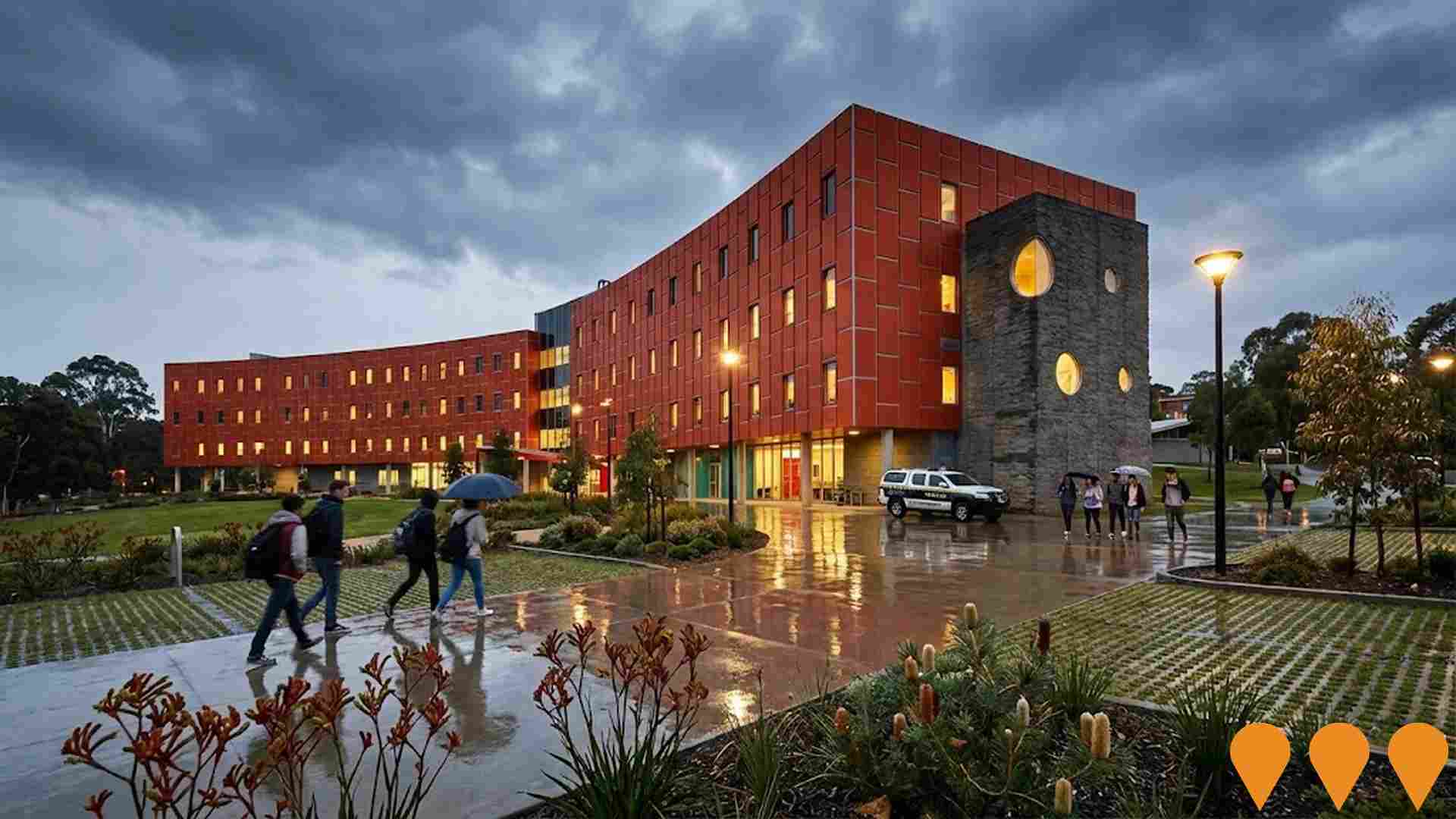
Bell Street Mall Neighbourhood Activity Centre Masterplan
Masterplan and Design Guide to revitalise Bell Street Mall (Melbourne's first drive-in shopping centre from 1956). Includes well-designed higher-density housing, preserving historic character, promoting economic growth, and urban design frameworks for building heights and landscaping.

Employment
Employment performance in Heidelberg West has been below expectations when compared to most other areas nationally
Heidelberg West has an educated workforce with prominent essential services sectors. Its unemployment rate was 6.8% in the past year, with estimated employment growth of 3.2%.
As of June 2025, 8,752 residents are employed, and the unemployment rate is 2.1% higher than Greater Melbourne's rate of 4.6%. Workforce participation is similar to Greater Melbourne's 64.1%. Key employment industries include health care & social assistance, education & training, and professional & technical services. Heidelberg West specializes in health care & social assistance, with an employment share 1.4 times the regional level.
Construction is under-represented, at 7.9% compared to Greater Melbourne's 9.7%. Many residents commute elsewhere for work. Between June 2024 and June 2025, employment levels increased by 3.2%, labour force grew by 1.4%, reducing the unemployment rate by 1.6 percentage points. In comparison, Greater Melbourne had employment growth of 3.5% and a 0.5 percentage point rise in unemployment. National employment forecasts from Jobs and Skills Australia (May 2025) project a 6.6% increase over five years and 13.7% over ten years. Applying these projections to Heidelberg West's employment mix suggests local growth of approximately 7.0% over five years and 14.4% over ten years, though this is a simple extrapolation for illustrative purposes only.
Frequently Asked Questions - Employment
Income
Income levels align closely with national averages, indicating typical economic conditions for Australian communities according to AreaSearch analysis
AreaSearch's data for financial year 2022 shows Heidelberg West had a median income of $54,329 and an average income of $66,527. For Greater Melbourne, these figures were $54,892 (median) and $73,761 (average). By September 2025, estimated incomes would be approximately $60,935 (median) and $74,617 (average), based on a 12.16% Wage Price Index growth since financial year 2022. The 2021 Census ranked Heidelberg West's household, family, and personal incomes modestly, between the 42nd and 45th percentiles. Income distribution shows that 32.1% of individuals earned $1,500 - 2,999 annually. Housing affordability pressures are severe, with only 80.5% of income remaining after housing costs, ranking at the 39th percentile. Heidelberg West's SEIFA income ranking places it in the fifth decile.
Frequently Asked Questions - Income
Housing
Heidelberg West displays a diverse mix of dwelling types, with a higher proportion of rental properties than the broader region
Heidelberg West's dwelling structure, as per the latest Census, consisted of 59.0% houses and 41.1% other dwellings (semi-detached, apartments, 'other' dwellings). In comparison, Melbourne metro had 76.0% houses and 24.0% other dwellings. Home ownership in Heidelberg West stood at 21.1%, with mortgaged dwellings at 30.5% and rented ones at 48.4%. The median monthly mortgage repayment was $2,059, lower than Melbourne metro's average of $2,167. The median weekly rent was $353, compared to Melbourne metro's $399. Nationally, Heidelberg West's mortgage repayments were higher at $2,059 versus the Australian average of $1,863, while rents were lower at $353 compared to the national figure of $375.
Frequently Asked Questions - Housing
Household Composition
Heidelberg West features high concentrations of group households and lone person households, with a lower-than-average median household size
Family households comprise 60.6% of all households, including 23.8% couples with children, 21.8% couples without children, and 13.0% single parent families. Non-family households make up the remaining 39.4%, with lone person households at 32.5% and group households comprising 6.9%. The median household size is 2.3 people, which is smaller than the Greater Melbourne average of 2.5.
Frequently Asked Questions - Households
Local Schools & Education
Educational attainment in Heidelberg West aligns closely with national averages, showing typical qualification patterns and performance metrics
Heidelberg West's educational profile is notable regionally, with university qualification rates at 39.6% of residents aged 15+, surpassing the Australian average of 30.4% and the SA4 region average of 32.8%. Bachelor degrees are most common at 24.7%, followed by postgraduate qualifications (11.0%) and graduate diplomas (3.9%). Vocational credentials are also prevalent, with 26.0% of residents aged 15+ holding such qualifications - advanced diplomas at 10.3% and certificates at 15.7%.
Educational participation is high, with 30.0% of residents currently enrolled in formal education. This includes tertiary education (8.4%), primary education (8.2%), and secondary education (5.9%). The area's three schools have a combined enrollment of 116 students and demonstrate typical Australian school conditions (ICSEA: 1003) with balanced educational opportunities. The educational mix consists of one primary school and two K-12 schools. School capacity is limited locally, with only 0.7 places per 100 residents compared to the regional average of 18.4, leading many families to travel nearby for schooling. Note: where schools show 'n/a' for enrolments, please refer to the parent campus.
Frequently Asked Questions - Education
Schools Detail
Nearby Services & Amenities
Transport
Transport servicing is high compared to other areas nationally based on assessment of service frequency, route connectivity and accessibility
Heidelberg West has 103 active public transport stops. These are served by 15 different bus routes that together facilitate 5,613 weekly passenger trips. Residents enjoy excellent transport accessibility, with an average distance of 156 meters to the nearest stop.
The service frequency is 801 trips daily across all routes, translating to about 54 weekly trips per individual stop.
Frequently Asked Questions - Transport
Transport Stops Detail
Health
Health outcomes in Heidelberg West are marginally below the national average with the level of common health conditions among the general population somewhat typical, though higher than the nation's average among older cohorts
Heidelberg West shows below-average health indicators compared to national averages. Common health conditions are somewhat typical but higher among older cohorts.
Private health cover stands at approximately 52%, slightly above the average SA2 area's rate of around 60% in Greater Melbourne, with about 8904 people residing there. The most prevalent medical conditions are mental health issues and asthma, affecting 10.7% and 8.6% of residents respectively. Around 68.3% report being free from medical ailments, compared to 69.3% in Greater Melbourne. The area has a lower proportion of seniors aged 65 and over at 13.3%, with around 2263 people, compared to the broader Greater Melbourne figure of 19.8%. Health outcomes among seniors require more attention than those for the general population.
Frequently Asked Questions - Health
Cultural Diversity
Heidelberg West is among the most culturally diverse areas in the country based on AreaSearch assessment of a range of language and cultural background related metrics
Heidelberg West has a high cultural diversity, with 32.5% of its population born overseas and 33.8% speaking a language other than English at home. Christianity is the main religion in Heidelberg West, accounting for 37.8% of people. Islam is overrepresented compared to Greater Melbourne's average, comprising 11.2% of Heidelberg West's population.
In terms of ancestry, the top three groups are English (20.2%), Australian (18.2%), and Other (15.8%), which is higher than the regional average of 8.7%. Notably, Greek (3.5%) and Lebanese (1.5%) populations are overrepresented compared to regional averages, while Italian representation is lower at 5.9% compared to the region's 7.7%.
Frequently Asked Questions - Diversity
Age
Heidelberg West's population is younger than the national pattern
Heidelberg West's median age is 35 years, which is slightly younger than Greater Melbourne's 37 and the national average of 38 years. The 25-34 age group constitutes 20.5% of Heidelberg West's population, higher than Greater Melbourne's percentage but lower than the national average of 14.5%. The 5-14 age cohort is less prevalent in Heidelberg West at 9.7%. Between 2021 and present, the 35-44 age group has increased from 15.2% to 17.2%, while the 15-24 age group has decreased from 11.4% to 10.7%. By 2041, population forecasts indicate that the 45-54 age cohort in Heidelberg West is projected to rise substantially by 85%, from 1,847 to 3,411 people.

